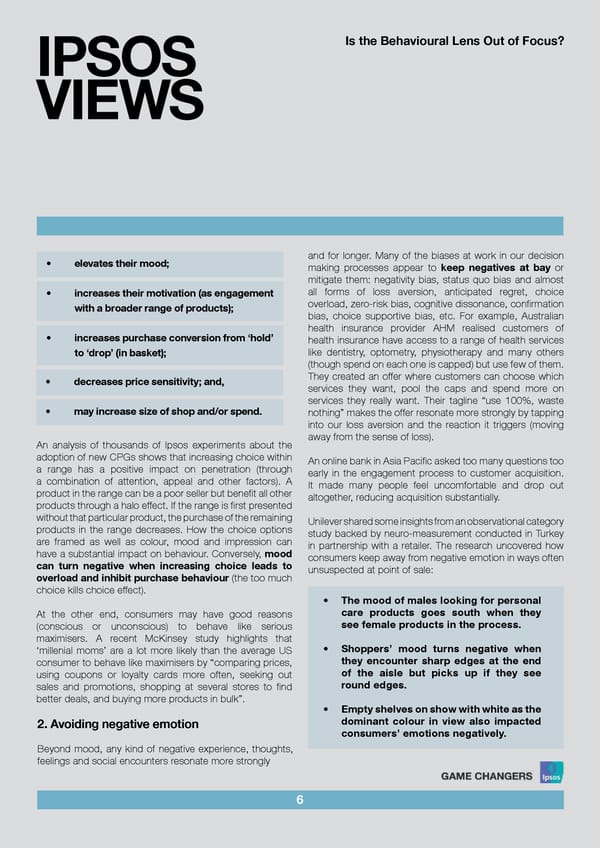IPSOS Is the Behavioural Lens Out of Focus? VIEWS and for longer. Many of the biases at work in our decision • elevates their mood; making processes appear to keep negatives at bay or mitigate them: negativity bias, status quo bias and almost • increases their motivation (as engagement all forms of loss aversion, anticipated regret, choice with a broader range of products); overload, zero-risk bias, cognitive dissonance, confirmation bias, choice supportive bias, etc. For example, Australian health insurance provider AHM realised customers of • increases purchase conversion from ‘hold’ health insurance have access to a range of health services to ‘drop’ (in basket); like dentistry, optometry, physiotherapy and many others (though spend on each one is capped) but use few of them. They created an offer where customers can choose which • decreases price sensitivity; and, services they want, pool the caps and spend more on services they really want. Their tagline “use 100%, waste • may increase size of shop and/or spend. nothing” makes the offer resonate more strongly by tapping into our loss aversion and the reaction it triggers (moving An analysis of thousands of Ipsos experiments about the away from the sense of loss). adoption of new CPGs shows that increasing choice within An online bank in Asia Pacific asked too many questions too a range has a positive impact on penetration (through early in the engagement process to customer acquisition. a combination of attention, appeal and other factors). A It made many people feel uncomfortable and drop out product in the range can be a poor seller but benefit all other altogether, reducing acquisition substantially. products through a halo effect. If the range is first presented without that particular product, the purchase of the remaining Unilever shared some insights from an observational category products in the range decreases. How the choice options study backed by neuro-measurement conducted in Turkey are framed as well as colour, mood and impression can in partnership with a retailer. The research uncovered how have a substantial impact on behaviour. Conversely, mood consumers keep away from negative emotion in ways often can turn negative when increasing choice leads to unsuspected at point of sale: overload and inhibit purchase behaviour (the too much choice kills choice effect). • The mood of males looking for personal At the other end, consumers may have good reasons care products goes south when they (conscious or unconscious) to behave like serious see female products in the process. maximisers. A recent McKinsey study highlights that ‘millenial moms’ are a lot more likely than the average US • Shoppers’ mood turns negative when consumer to behave like maximisers by “comparing prices, they encounter sharp edges at the end using coupons or loyalty cards more often, seeking out of the aisle but picks up if they see sales and promotions, shopping at several stores to find round edges. better deals, and buying more products in bulk”. • Empty shelves on show with white as the 2. Avoiding negative emotion dominant colour in view also impacted consumers’ emotions negatively. Beyond mood, any kind of negative experience, thoughts, feelings and social encounters resonate more strongly 6
 Is the Behavioural Lens Out of Focus? Page 7 Page 9
Is the Behavioural Lens Out of Focus? Page 7 Page 9